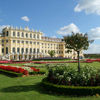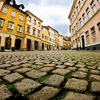Best European Castles and Palaces
Lindsey Wooldridge
Europe’s many castles and palaces are favored tourist destinations for visitors. However, if you go to too many, they tend to get a little boring. To help you decide which ones to visit, check out our list of the top 10 castles and palaces that are worth a visit.
Neuschwanstein Castle
This castle near Munich, Germany, is one of the most famous Bavarian castles in Europe. This castle is covered in turrets and spires, and offers a great view of a nearby river. This castle served as the model for Sleeping Beauty’s castle at Disney World. Tours of the castle and grounds are available. The castle is open daily from 9am-6pm (April-September) and 10am-4pm (October-March). Admission starts at 9€. (http://www.neuschwanstein.de/englisch/palace/index.htm).
Leeds Castle
Leeds Castle in Kent, England is often called “the loveliest castle in the world”. The castle was built in 857 and was the home to Edward I, Henry V, and Henry VIII, among others. Though the structure itself can be underwhelming, the grounds are gorgeous and the castle is filled with old paintings, tapestries, and furniture. There is even an aviary on the property and a black-tie dinner served in the castle for an extra fee. Open daily from 10:30am-4pm. Admission is £15. (www.leeds-castle.com).
Glamis Castle
This castle in Glamis, Scotland, is reputed to be the most haunted castle in the country. Myths and ghost stories about Glamis abound. It is rumored that many people, including royalty, have been murdered in the castle. Locals warn that it only safe to visit during the day; evening and early morning visits are only for the very brave. The castle is open from March-December from 10am-6pm. Admission from £7. (www.glamis-castle.co.uk).
La Alhambra
Built by Muslim kings in the 1300s, the Alhambra (Granada, Spain) was later taken over by Europeans in 1492. The mixing of these two cultures is seen in the fascinating grounds and structures. The Alhambra is a sprawling complex that contains castles, fortresses, ruins, dungeons, artwork, and more. Though it is often crowded with tourists, it is a must see. Open daily from 8:30am-6pm (November-February) and 8:30am-8pm (March-October). Admission starts at 12€. (www.alhambra.org).
Chateau du Blois
Located in the Loire Valley of France, Chateau du Blois has been home to several French kings. This castle was also the where Joan of Arc received a blessing before going to war against the English. The castle is made up of several buildings built between the 13th and 17th centuries. The castle contains hundreds of authentic artifacts, such as paintings, sculptures, and furnishings. This is a great castle for those interested in French history. Open daily from 9am-5:30pm (January 2-March 31 and October 1-Decmber 31), 9am-6:30pm (April 1-June 30 and September 1-September 31), and 9am-7pm (July 1-August 31). Admission starts at 7.5€. (www.chateaudeblois.fr).
Versailles
Louis XVI’s astounding palace outside of Paris, France is one of the most famous royal residences in the world. After it was built by Louis XVI in the 1600s, it was used as the official royal residence and center of French government for over 100 years. It is unbelievable how ornate, detailed, and over-the-top the palace and its grounds are. Be prepared to make this a day trip. Open Tuesday-Sunday from 9am-5:30pm (November-March) and 9am-6:30pm (April-October). Admission ranges from 16-20€. (http://www.chateauversailles.fr/en/).
Pena Palace
This palace near Lisbon, Portugal, is the oldest (and best) example of European Romantic architecture. The palace sits on the peaks of the Serra de Sintra and has an amazing view of Lisbon and its surrounds. The structures and the artwork inside are an interesting blend of Moorish, Gothic, and traditional European inspirations. The palace is still used for state occasions by the President of Portugal and other ranking government officials. Open daily from 10am-6pm. Admission is 8€. (http://www.parquesdesintra.pt/en/).
Blenheim Palace
Blenheim Palace (Oxfordshire, England) was the birthplace of Winston Churchill. The palace itself is relatively small (for a palace), but it has hundreds of authentic artifacts such as suits of armor, paintings, china, and more. The highlight of the palace is the surrounding grounds. The palace is situated on 2100 acres bordering a lake. The property contains, walking trails, a rose garden, a maze, and much more. Open Wednesday-Sunday from 9am-4:45pm. Admission starts at £14.50. (http://www.blenheimpalace.com/).
Diocletian’s Palace
This Roman palace built in 4 BCE is found in Split, Croatia. Though parts of the palace are no longer standing, much of the palace now serves as the center of the town of Split. The beautifully preserved old Roman architecture is breathtaking. Tours of the ruins of the palace and the city are available at 11am (November-April) and 10am, 12pm, and 7pm (May-October). Tours cost 90kn. (www.visitsplit.com).
Schonbrunn Palace
Considered one of the most beautiful baroque palaces in Europe, Schonbrunn (Vienna, Austria) was once the summer residence of the Austrian royal family. The enchanting palace is world famous for its history, unique grounds, and impressive furnishings. Open daily from 8:30am-5pm (April 1-June 30 and September 1-October 31), 8:30am-6pm (July 1-August 31), and 8:30am-4:30pm (November 1-March 31). Admission from 9.50€. (www.schoenbrunn.at/en).
Featured Articles
No-one likes to be cliché but when you're faced with planning a trip to Europe it can be tempting to follow the crowd.
The UK is known for many things: rain, a scandalous royal family, old buildings and bad food all spring to mind.
People often think that travel in Europe is easy; that cultural gaffes aren’t an issue and that the challenges of Africa or Latin America don’t apply.
Every year in August people get together to throw tomatoes at each other. I hate tomatoes, I think they are disgusting, so...
Free Backpacking Europe Planning & Essentials Guide
Download/More info on the Backpacking Planning and Essentials Guide
Featured Articles
No-one likes to be cliché but when you're faced with planning a trip to Europe it can be tempting to follow the crowd.
The UK is known for many things: rain, a scandalous royal family, old buildings and bad food all spring to mind.
People often think that travel in Europe is easy; that cultural gaffes aren’t an issue and that the challenges of Africa or Latin America don’t apply.
Every year in August people get together to throw tomatoes at each other. I hate tomatoes, I think they are disgusting, so...
Free Backpacking Europe Planning & Essentials Guide
Download/More info on the Backpacking Planning and Essentials Guide






